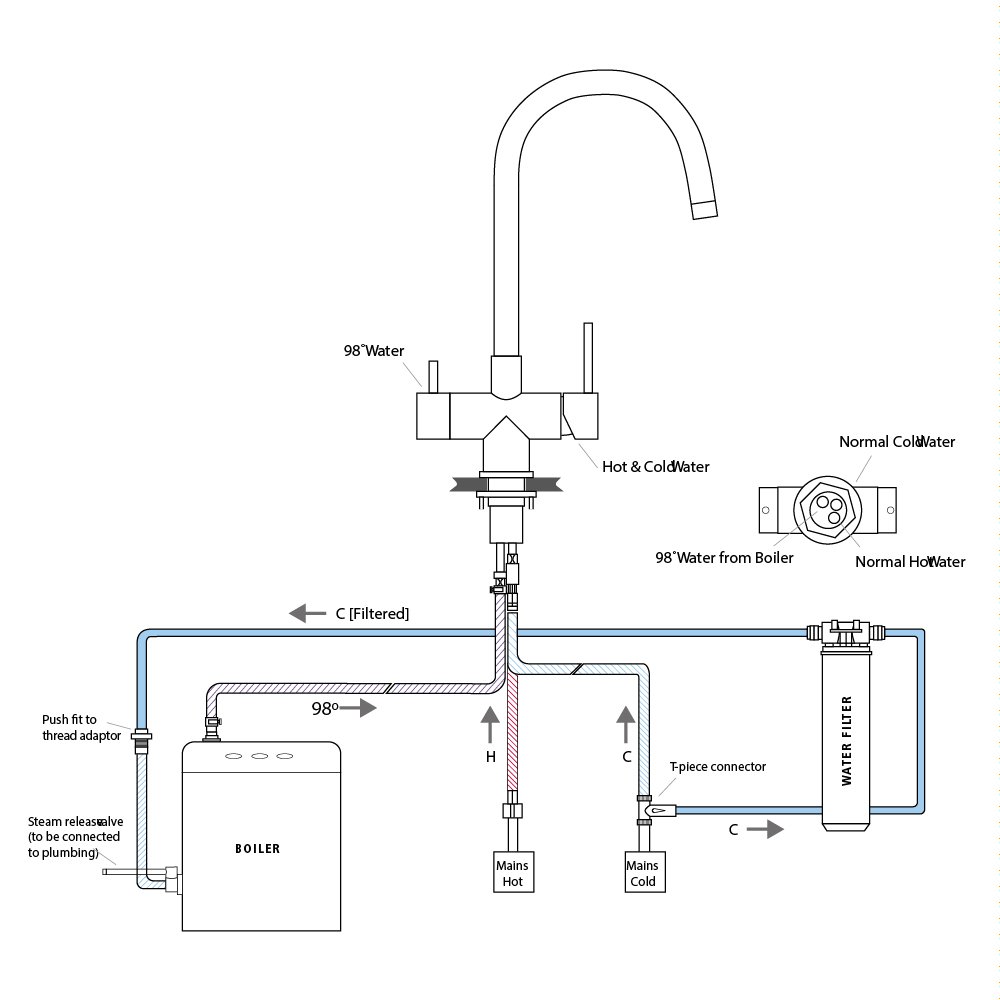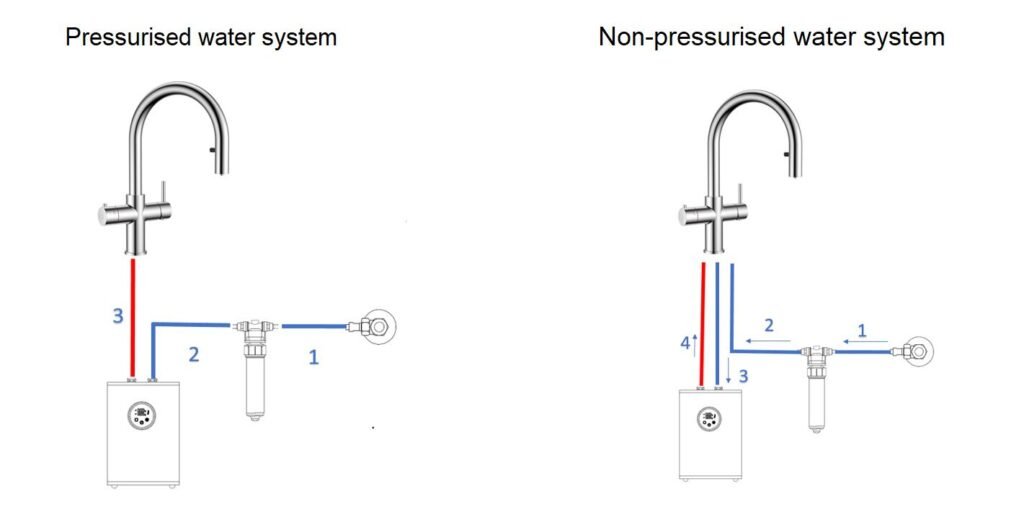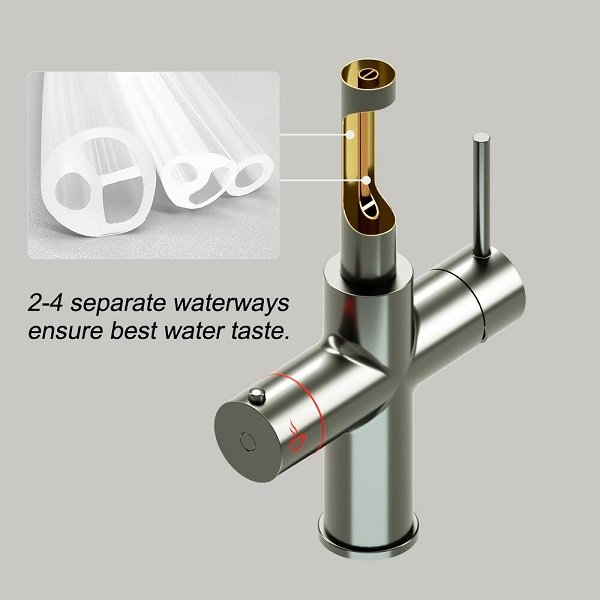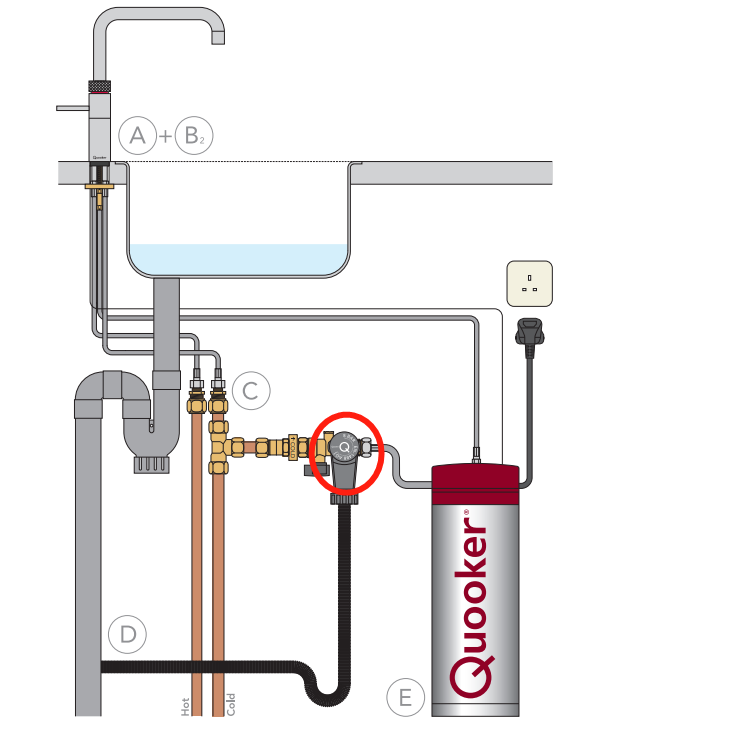
For the boiling water system, we usually call it non-pressure under sink water system. During Hcdrink’s service work, the most frequent reminder we give to our customers is that Hcdrink’s boiling water system is a non-pressure water system. The vent is not on the boiler, but it is the outlet of the tap. So the boiler needs to be equipped with a low-pressure water tap.
Some customers do not get clearly the working principle of the whole system and connect the normal kitchen faucet to the Hcdrink’s water boiler. Which caused leakage of the water boiler. In our record, there are 4 cases of leakage caused by connecting with a normal kitchen mixer.
This article will give a detailed introduction to low-pressure tap and nonpressurized water heaters or what we call water boilers.
What is pressure?
First of all, we need to clarify what the pressure refers to here?
This pressure does not refer to the water pressure from the house valve but refers to the pressure for the storage tank of the water boiler, the pressure of the hot water tank from two sources, one is the water pressure, the other is the steam pressure when the water is heated.
Water pressure has 2 resources.
- One is the water pressure from the water-filled water tank, according to the pressure formula:
F = PS = ρghS (ρ is the density of water, g is a constant 9.8N/kg counted as 10N/kg, h is the depth of the water, S is the bottom area of the water tank)
We can calculate the bottom pressure of the water tank of the 2.4L Hcdrink water boiler as
(height=20cm, diameter=12cm) :
F=PS=ρghS=1.0×10³×10×0.2×3.14×(12/2/100) 2≈20N=2kgs
- On the other hand, the water pressure is the water pressure of the municipal water supply
Without calculating complexly for gravity-fed in a gravity-fed system, we can test it easily, we can connect a water pressure reading meter at the water supply end, we will be able to know the value of the water pressure, the normal water pressure is generally between 40 and 60PSI, most of the family will adjust at 50PSI, about 3.5kgs.
If the water boiler is connected to a normal faucet that supplies normal hot and cold water, then the water tank needs to withstand 2kgs + 3.5kgs = 5.5kgs of pressure without heating water, which is about 80PSI of pressure. So a cold water tank has 5.5kgs pressure during working.
If you calculate the pressure of steam, for example, the water is heated to 98 degrees, you can imagine that there is a great risk of breaking the water tank if there is no vent on the boiler. The method of calculating steam pressure is complicated, so instead of explaining it in detail here, you can refer to the following calculation link.
Let’s check how the normal faucet works.
First, look at the picture below on the left. A traditional kitchen faucet when it does not work has the spout in a completely closed position and does not allow any overflow. If you connect an ordinary faucet to a water boiler without a vent, water from the municipal water supply channel goes through a hose into the tank and flows out from a hot water pipe. So we are heating a sealed tank full of water, the water boiler bears not only the water pressure and the steam pressure when the water is boiling, water trapped in the tank, simply due to the thermal expansion of the liquid will make the pipe or boiler break. It is easy to understand that the boiler is under very high pressure. And we can call such systems high-pressure water systems. Many people will consider installing the boiling water tap on the following way basis on the way to a normal faucet.

In fact, we should find a solution to release the pressure on the tank.
The working diagram of a low-pressure water system or what we call a non-pressure system is shown in the diagram below on the right.
In appearance, the boiling water tap of the low-pressure system is not different from a normal kitchen faucet. However, the design of the water flow is completely different. It has two hoses connected to the water boiler, one is for supplying water to the faucet, the second one is for the faucet to the water boiler, and the third one is for the water outlet so that we have three hoses instead of two. In the boiling water faucet, the spout of the boiling water is always kept open, when we turn the boiling water handle, the municipal water flows into the cartridge of the faucet, and then the cold water from the faucet cartridge will flow into the water boiler at a lower pressure from the faucet, so the boiling water which has equal quantity as the cold water will be squeezed out from the hot water tank. The outlet of the boiling water faucet works as an open vent, and the faucet will bear the municipal water instead of the water boiler. The water boiler only needs to carry the pressure of 2kgs of water in the tank.
This structure is the same as the low-pressure tap for the hot water cylinder.

So, to summarize, the spout of a low-pressure faucet remains open at all times, and opening the faucet causes cold filtered water to flow into the boiler, then pushing the hot water upward. Thus, the low-pressure faucet reacts to the expansion of the water in each heating stage with a drop by drop overflow, of course in the boiling water system there is an ingenious design to suck back this expanded water, which we call the venturi system, as we will explain in detail in the next article. Conversely, if the water boiler as an unvented system is combined with a normal kitchen faucet, the boiler will be damaged. The normal kitchen faucet locks the spout completely in the closed position and does not allow any overflow to release the high pressure.
The left picture shows a transparent silicone tube that connects from the boiler outlet to the faucet outlet. Which not only delivers boiling water but also works as a pressure relief valve at all times.
And in fact, in all of Hcdrink’s 2in1, 3in1, 4in1, and 5in1 boiling water taps, the internal structure is more complex than the above explanation, not only work for boiling water, at the same time they works also as a normal kitchen faucet to deliver room temperature and warm water for cleaning. According to our design, the right handle controls hot and cold water, so everyone uses the faucet easily as a normal kitchen faucet not only from the appearance.
But in order to separate the pipes for drinking water and washing water, and separate pipes for boiling water and chilled water, Hcdrink has developed a multi-waterway silicone tube, as I believe the picture below shows at a glance.

By now, I believe you must have the basic concept, the called non-pressure systems, low water pressure systems, it is still pressured, but the pressure is borne by the faucet, then there are special requirements for the faucet, suitable for the pressureless system of water taps.
In the market, there is also a part of the pressure systems for under sink boiling water system, such as Quooker, Grohe Red, Zip, you may ask how to release the high pressure from the steam? It is by adding a pressure relief valve on the water boiler, that steam needs to be released into the waste pipe, the disadvantage of this system is that the installation is more complex.

Tips:
- Make sure the minimum water pressure for a boiling water system. We can check it in the installation manual.
- Make sure there is no blockage of the water connection. It is important for both unpressurized and pressurized systems.
